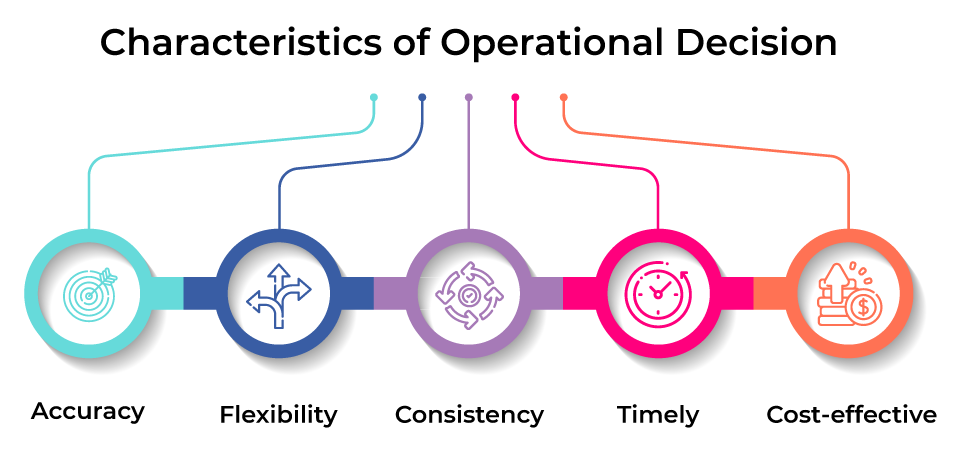
Business users are every day faced with situations where they have to make decisions that can have long-term impacts. Therefore, it is important to ensure that these decisions are accurately made. There are different types of business decisions, like Strategic, Tactical, and Operational. Operational decisions are made to carry out the short-term procedures and achieve the long- and medium-term objectives adopted by the strategic and tactical level decisions. Let us dive deep into understanding the operational decisions that affect businesses’ everyday operations.
What are Operational Decisions?
Operational decisions are short-term choices that are typically made on a weekly, daily, or hourly basis. They are primarily concerned with operational details, daily resource allocation, inventory control, and delivery routing to maximize product flow along biomass-based production chains. Due to the changing internal and external conditions of supply chains and related activities, operational decisions might be changed and amended often.
Operational decisions consist of three steps:
- Input Data
- Decision Logic
- Output or action
Characteristics of Operational Decision

Accuracy
Good operational decisions behave like informed employees with the appropriate reports and analysis, using data quickly and effectively to take the right action. Instead of just being aware of the past, they use this data to get insight into the future and use that understanding to behave more appropriately. Through micro-segmentation and intense customization, they target their customers using information about them.
Flexibility
Operational choices must be made quickly to reflect new possibilities, organizations, and threats; otherwise, their value will quickly deteriorate. No modern business system can endure protracted periods of static. Given the current competitive, economic, and regulatory context, it is impossible. When businesses automate their transactions and procedures, they frequently discover that how rapidly they can alter their information systems greatly affects how quickly they react to change. Operational decisions must be simple to alter quickly and effectively to reduce missed opportunity costs and increase overall business agility.
Consistency
Your operational decisions must be consistent throughout time and space across many channels you use to conduct business, including the web, mobile devices, interactive voice response systems, Auto attendant systems and kiosks. They enable you to act differently when you desire to, such as offering a reduced price online to promote the usage of a lower-cost channel, but they make sure that you don’t act differently unintentionally. These systems support the people who directly work for you and the third parties and agents who represent you. They ensure you stay out of trouble by upholding your company’s laws, rules, and social preferences everywhere it conducts business. They continually provide your employees with a top-notch experience.
Timely
You need to act as quickly as possible. Your competition is only three clicks away, as they say online. Your coworkers are developing short attention spans and a lack of patience. The systems that manage your supply and demand chains must act swiftly and shrewdly as they become more real-time. You must reduce wait times for these associates as fewer staff handle more clients, partners, and suppliers. You must make a choice swiftly and take action.
Cost-effective
Operational choices must, above all, be economical. Cost cutting is still crucial despite significant efficiency improvements and reductions in previous years. Effective operational choices reduce costly reports and needless tasks. They lessen fraud and avoid penalties. They enable your employees to work more effectively and allocate their time wisely. They ensure that you get as many things correctly the first time and steer clear of costly “do-overs.” They lessen friction, which slows down operations and raises expenses.
Also Read: What are Enterprise-Grade Applications? Top Tips for Building
Examples of Operational Decisions that Businesses make
- Monthly and daily forecasts to determine the demand from end users.
- Determining the deadline for satisfying demand and analyzing the variances between lead time and deadline.
- Scheduling and planning for daily and weekly production.
- Assigning a cargo of biomass products or sources to a certain method of transportation and vehicle.
- Routes and timetables for daily and weekly deliveries, fleet management.
- Keeping track of supply shortfalls and backlogs, planning additional daily and weekly operations to address the shortages.
- Control and replenishment of inventories every day and every week.
- Scheduling the work and keeping shifts.
How are Operational Decisions different from Strategic Decisions?
Strategy is little more than wishful thinking with limited prospects of realisation without practical decision-making. Conversely, operational decisions that are not supported by strategic decisions are frequently arbitrary and lack a unifying factor that establishes a company’s growth objectives.
Therefore, operational decisions relate to how organisations carry out their strategic decisions. Operational decisions are how an organisation achieves its strategic objectives; they are growth-oriented and geared toward manufacturing.

Automation of Operational Decision
Even though automating operational decisions aids an organization’s effectiveness and efficiency, businesses frequently attempt to automate these processes via traditional methods, such as writing code, iBPMS, RPA, DPA, and other technologies. Businesses create applications that automate operational decisions using codes and low-code platforms. Companies have also begun adopting spreadsheet programs like Excel to assist employees with difficult calculations. Additionally, they have built automated operational decisions utilizing other business-oriented solutions, including business rules management systems (BRMS), decision management solutions (DMS), and business process management (BPM).
However, delivering business value successfully depends on automating operational decisions, but burying decisions, data, and necessary actions within processes and applications makes it exceedingly challenging for firms to keep up. It pushes the limits of technological platforms and corporate procedures and produces less fruitful outcomes.
Also Read: What is Decision Automation and how can you drive it?
Three business challenges were solved by automating Operation Decisions
Smart Workflows
Workflows for automated decision-making must be regularly modified to account for the new information received from various interconnected data points. Each data point is selected and set up depending on particular characteristics. Automated operational decisions are made based on analyzing changes observed in the various data point properties. Workflows become more intelligent when this occurs without a hitch.
Contractual and Regulatory Compliance
Regulatory compliance is also aided by automated decision-making. A theatre’s audio setup serves as an illustration. An automated judgment will turn down the decibels if they reach unsafe levels. This degree of automated decision-making and action can boost adherence to corporate policies and sector regulations.
Automatic Error Recovery and Prevention
An automated workflow system can spot possible mistakes and decide whether to fix them or react without the need for human interaction. These levels of automation make systems faster and more reliable by accelerating the detection and correction of problems.
Also Read: A Complete Guide to Workflow Automation Software
Importance of Operational Decisions
Quick, flawless, and consistent decisions
The capacity to take quick, accurate decisions is the main benefit. By shifting human decision-making to an automated process, also maintains consistency. As a result, artificial intelligence can fix itself and take corrective action without ongoing oversight. Every business decision is subjected to this automation continuously, around the clock, leaving no opportunity for error or inconsistency.
Greater staff utilization
Employees can focus on tasks that will increase income production and provide new opportunities by decreasing the need for human participation in repetitive processes.
Growing Compliance
Organizations can avoid paying penalties for non-compliance by reducing the incidence of regulatory or contractual errors. Although it does reduce the likelihood of error, decision automation does not entirely eliminate it.
How Quixy can help in Operational Decision Management Tool
Quixy, a no-code platform, can significantly aid in operational decision-making by streamlining processes, enhancing collaboration, and providing data-driven insights. Here’s how:
- Process Automation
Quixy allows users to automate various operational processes without writing any code. Automating repetitive tasks such as data entry, approvals, and notifications frees up time for decision-makers to focus on more strategic matters. - Workflow Management
The platform enables the creation and management of complex workflows tailored to specific operational needs. Decision-makers can design workflows that ensure tasks are completed efficiently, deadlines are met, and dependencies are managed effectively. - Real-time Data Visibility
Quixy provides real-time visibility into operational data through customizable dashboards and reports. Decision-makers can access up-to-date information on key performance indicators, process bottlenecks, and resource utilization, empowering them to make informed decisions quickly. - Collaboration Tools
Quixy facilitates collaboration among teams by centralizing communication, document sharing, and task assignment within the platform. Decision-makers can easily collaborate with stakeholders, gather feedback, and ensure everyone is aligned toward common goals. - Predictive Analytics
Leveraging the data collected within the platform, Quixy can offer predictive analytics capabilities. Decision-makers can use predictive insights to anticipate future trends, identify potential risks, and optimize operational strategies accordingly. - Continuous Improvement
Quixy supports a culture of continuous improvement by enabling users to collect feedback, track performance metrics, and iterate on processes. Decision-makers can use this feedback loop to identify areas for optimization and implement changes iteratively. - Compliance and Risk Management
Quixy helps ensure compliance with regulations and internal policies by incorporating compliance checks and controls into workflows. Decision-makers can mitigate risks by enforcing standardized processes and monitoring compliance in real time.
Quixy empowers decision-makers by automating processes, providing real-time insights, fostering collaboration, and enabling continuous improvement. By leveraging the platform’s capabilities, organizations can enhance their operational efficiency and agility, ultimately driving better decision-making outcomes.
Wrapping Up
Modern businesses simply cannot scale with traditional methods when faced with complicated operational decisions. Some have even attempted to connect data and processes using one of the various decision management tools. However, that strategy produces a disjointed decision experience that frequently becomes impossible in challenging circumstances.
No-code platforms enable business users to build solutions and applications. Businesses can automate their decision-making through faster approvals and analysis. This empowers the organization to become more agile. Check out Quixy’s no-code capabilities and how it can help you automate those decisions.
Frequently Asked Questions(FAQs)
What are examples of operational decisions?
Some examples of Operational Decisions are Inventory management, pricing, and production scheduling.
What are operational decisions also known as?
Operational decisions are known as Tactical decisions.
What is operational decision-making in management?
It’s the process where managers make real-time choices to execute the company’s strategies effectively. It’s about the nitty-gritty details that drive daily operations.
What are the features of operational decisions?
Operational decisions are characterized by their short-term focus, routine nature, and direct impact on daily activities. They’re typically data-driven and involve specific, concrete actions.
What is the operational process and example?
An operational process is a series of steps to achieve a specific task. For instance, a retail store’s operational process for restocking might involve checking inventory, placing orders, receiving shipments, and updating stock records.
Subscribe
Login
Please login to comment
0 Comments
Oldest
















